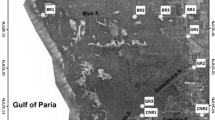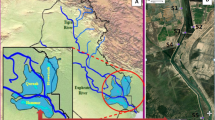Abstract
Cd, Zn, Cu, As, Fe, Cr, Ni, Al, and Pb were analyzed in the edible and inedible parts of the muricid gastropod Hexaplex trunculus sampled along the Tunisian coast in 2004, 2007, and 2011. The concentration ranges (μg/g dry weight) in the whole soft tissue were 0.1–19.2 for Cd, 198.7–564.6 for Zn, 31.9–363.1 for Cu, 12.8–177.8 for As, 35.4–179.0 for Fe, 0.0–5.8 for Cr, 0.1–4.6 for Ni, 1.0–41.4 for Al, and 0.0–0.6 for Pb. The highest concentrations were recorded in Gabès for Cd, Menzel Jemil for Zn and Cu, Bizerte channel for As, Zarat for Cr and Pb, and Tunis North Lake for Fe, Al, and Ni. The European standards compiled by FAO for mollusks were exceeded in several localities. The temporal trends revealed a decreasing metal contamination in most sampling stations from 2004 to 2011. The calculated intake of metals (μg/week/kg body weight) through human consumption of the snail edible portion varied from 0.0 to 4.4 of Cd, 55.9 to 172.1 of Zn, 8.7 to 92.7 of Cu, 3.0 to 42.6 of As, 9.5 to 49.1 of Fe, 0.0 to 1.52 of Cr, 0.0 to 1.4 of Ni, and 0.3 to 11.4 of Al. Comparison of these metal intakes with those of the standard provisional tolerable weekly intake (PTWI) values stipulated by the WHO recommends precaution in terms of human consumption of this marine snail.




Similar content being viewed by others
References
AAMP (2014) Agence des Aires Marines Protégées de France. Plan de gestion du Parc naturel marin du golfe du Lion. 670pp
Axiak V, Vella AJ, Micallef D, Chircop P, Mintoff B (1995) Imposex in Hexaplex trunculus (Gastropoda: Muricidae): First results from biomonitoring of tributyltin contamination in the Mediterranean. Mar Biol 121:685–691
Ayadi N, Aloulou F, Bouzid J (2015) Assessment of contaminated sediment by phosphate fertilizer industrial waste using pollution indices and statistical techniques in the Gulf of Gabes (Tunisia). Arab J Geosci 8:1755–1767
Béjaoui B, Rais S, Koukitounsky V (2004) Modelisation de la dispersion du phosphogypse dans le golfe de Gabes. Bull Inst Nat Sci Tech Mer 31:103–109
Belkhodja H, Missaoui H, Romdhane MS (2012) Trace metals in molluscs Patella caerulea (Linnaeus, 1758) from Tunisian Northcoasts, Mediterranean Sea. Cah Biol Mar 53:243–254
Ben Garali A, Ouakad M, Gueddari M (2010) Contamination of superficial sediments by heavy metals and iron in the Bizerte lagoon, northern Tunisia. Arab J Geosci 3:295–306
Ben Khelil M, Ben Said O, Nefzi R, Ben Abdelmalek J, Aïssa P (2012) Étude expérimentale de l’évolution en microcosme du chrome (VI) dans l’eau de mer et de ses effets sur la macrofaune et les bactéries indigènes de la Lagune de Bizerte (Tunisie). J Wat Sci 25:221–234
Ben Maïz N (2011) Le lac nord de Tunis: un modèle de réhabilitation et de gestion d’unezone humide située en milieu urbain. MediterraneanWetlands Initiat Present 59
Ben Khedher S, Jebali J, Houas Z, Nawéli H, Jrad A, Banni M, Boussetta H (2014) Metals bioaccumulation and histopathological biomarkers in Carcinus maenas crab from Bizerta lagoon, Tunisia. Environ Sci Pollut Res 21:4343–4357
Boumaza N (2006) Villes réelles, villes projetées. Villes maghrébines en fabrication, Paris, Editions Maisonneuve et Larose 691
Bouquegneau JM, Martoja M (1987) Seasonal variation of the cadmium content of Murex trunculus in a non cadmium polluted environment. Bull Env Cont Tox 39:69–73
Catsiki AV, Arnoux A (1987) Étude de la variabilité des teneurs en Hg, Cu, Zn et Pb de trois espèces de mollusques de l’étang de Berre (France). Mar Env iron Res 21:175–187
Chouba L, Kraiem M, Njimi W, Tissaoui CH, Thompson JR, Flower RJ (2007) Seasonal variation of heavymetals (Cd, Pb and Hg) in sediments and in mullet, Mugilcephalus (Mugilidae), from the Ghar El Melh Lagoon (Tunisia). Trans Wat Bull 4:45–52
Chouba L, Tissaoui CH, El Abed A (2008) Etude de la concentration des métaux traces chez Hexaplextrunculus (muricidae) le long du littoral tunisien. Bull Ins Nat Sci Tech Mer Salammbô 35:73–79
Claisse D, Alzieu C (1993) Copper contamination as a result of antifouling paint regulations? Mar Pollut Bull 26:395–397
Codex Alimentarius Commission (2007) Joint FAO/WHO Food Standards Programme, Codex Committee on Contaminants in Foods, 1st Session. working document forinformation and use in discussions related to contaminants and toxins of the GSCTF.CX/CF 07/1/6. Bei**g, China
Darmoul B (1988) Pollution dans le Golfe de Gabès (Tunisie): bilan des six années de surveillance (1976-1981). Bull Ins Nat Sci Tech MerSalammbô 15:61–84
Darmoul B, Vitiello P (1980) Recherches expérimentales sur la toxicité aiguë des rejets de phosphogypse sur quelques organismes benthiques marins 7: 63–89
de Mora S, Fowler SW, Wyse E, Azemard S (2004) Distribution of heavy metals in marine bivalves, fish and coastal sediments in the Gulf and Gulf of Oman. Mar Pollut Bull 49:410–424
El Zrelli R, Courjault-Radé P, Rabaoui L, Castet S, Michel S, Bejaoui N (2015) Heavy metal contamination and ecological risk assessment in the surface sediments of the coastal area surrounding the industrial complex of Gabes city, Gulf of Gabes, SE Tunisia. Mar Poll Bull 101:922–929. doi:10.1016/j.marpolbul.2015.10.047
Elhasni K, Ghorbel M, Vasconcelos P, Jarboui O (2010) Reproductive cycle and size at first sexual maturity of Hexaplextrunculus (Gastropoda: Muricidae) in the Gulf of Gabès (Southern Tunisia). Invertebr Rep Dev 54:213–225
Ennouri R, Chouba L, Kraiem MM (2008) Evaluation de la contamination chimique par les métaux traces (Cd, Pb, Hg et Zn) du zooplancton et de la sardinelle (Sardinellaaurita) dans le golfe de Tunis. Bull Ins Nat Sci Tech Mer Salammbô 35:87–94
Ennouri R, Chouba L, Magni P, Kraiem MM (2010) Spatial distribution of trace metals (Cd, Pb, Hg, Cu, Zn, Fe and Mn) and oligo-elements (Mg, Ca, Na and K) in surface sediments of the Gulf of Tunis (Northern Tunisia). Environ Monit Assess 163:229–239
Evans SM, Kerrigan E, Palmer N (2000) Causes of imposex in the Dogwhelk Nucella lapillus (L.) and its use as a biological indicator of tributyltin contamination. Mar Pollut Bull 40:212–219
Francesconi KA, Edmonds JS (1997) Arsenic and marine organisms. Adv Inorg Chem 44:147–189
Garaventa F, Centanni E, Fiorini S, Noventa S, Faimali M, Terlizzi A, Pavoni B (2008) New implications in the use of imposex as a suitable tool for tributyltin contamination: Experimental induction in Hexaplex trunculus (Gastropoda, Muricidae) with different stressors. Cell Biol Toxicol 24:563–571
Ghannem N, Gargouri D, Sarbeji MM, Yaich C, Azri C (2014) Metal contamination of surface sediments of the Sfax–Chebba coastal line. Tunisia Environ Earth Sci 72:3419–3427
Gharbi-Bouraoui S, Gnassia-Barelli M, Roméo M, Dellali M, Aïssa P (2008) Field study of metal concentrations and biomarker response in the Neogastropod, Murex trunculus, from Bizerta Lagoon (Tunisia). Aqua Liv Res 21:213–220
Gharsallah IH, Vasconcelos P, Zamouri-Langar N, Missaoui H (2010) Reproductive cycle and biochemical composition of Hexaplextrunculus (Gastropoda: Muricidae) from Bizerte lagoon, northern Tunisia. Aquat Biol 10:155–166
Hamza-Chaffai A, Roméo M, El Abed A (1996) Heavy metals in different fishes from the middle eastern coast of Tunisia. Bull Env Cont Tox 56:766–773
IARC (2012) A review of human carcinogens. part C: arsenic, metals, fibres, and dusts. IARC monographs on the evaluation of carcinogenic risks to humans. 100C. IARC, Lyon, 501 pp
KessabiK HZ, Sassi A, Said K, Messaoudi I (2014) Heavy metal accumulation and histomorphological alterations in Aphaniusfasciatus (Pisces, Cyprinodontidae) from the Gulf of Gabes (Tunisia). Environ Sci Pollut Res 21:14099–14109
Kharroubi A, Gargouri D, Baati H, Azri C (2012) Assessment of sediment quality in the Mediterranean Sea–Boughrara lagoon exchange areas (southeastern Tunisia): GIS approach-based chemometric methods. Environ Monit Assess 184:4001–4014
Ladhar-Chaabouni R, Machreki-Ajmi M, Hamza-Chaffai A (2009) Spatial distribution of cadmium and some biomarkers in Cerastodermaglaucum living in a polluted area. Mar Biol Res 5:478–486
Lahbib Y, Abidli S, Chiffoleau JF, Averty B, Trigui El Menif N (2009) First record of butyltin body burden and imposex status in Hexaplex trunculus from the Tunisian coast. J Environ Monit 11:1253–1258
Lahbib Y, Abidli S, Trigui El Menif N (2011) Reproductive activity in the commercially exploited Mediterranean Muricid Hexaplextrunculus collected from Boughrara Lagoon (Southern Tunisia). Russ J Mar Biol 37:501–508
Lahbib Y, Mleiki A, Marigomez I, El Menif N (2013) Copper, zinc, and cadmium body concentrations in Hexaplextrunculus collected from the Tunisian coast. Envir Monit Assess 185:8967–8975
Lorenzini G, Orlando E (1994) Accumulo di cadmio in Murex trunculus L (Gastropoda). Biol Mar Mediterranea 11:279–280
Machreki-Ajmi M, Hamza-Chaffai A (2008) Assessment of sediment/water contamination by in vivo transplantation of the cockles Cerastodermaglaucum from a noncontaminated to a contaminated area by cadmium. Ecotoxicology 17:802–810
María-Cervantes A, Jiménez-Cárceles FJ, Álvarez-Rogel J (2009) As, Cd, Cu, Mn, Pb, and Zn contentsin sediments and mollusks (Hexaplextrunculus and Tapes decussatus) from coastal zones of a Mediterranean lagoon (Mar Menor, SE Spain) affected by mining wastes. Wat Air Soil Poll 200:289–304
Martoja M, Bouquegneau M (1988) Murextrunculus: Un nouveau cas de pseudo-hermaphrodisme chez un gastéropode prosobranche. Bull Soc Roy Sci Liège 57:45–58
Mensi GS, Moukha S, Creppy EE, Maaroufi K (2008) Metals accumulation in marine bivalves and seawater from the Lagoon of Boughrara in Tunisia (North Africa). Int J Environ Res 2:279–284
Nias DJ, McKillup SC, Edyvane KS (1993) Imposexin Lepsiella vinosa from Southern Australia. Mar Pollut Bull 26:380–384
Ochsenkühn-Petropulu M, Varsamis J, Parissakis G (1997) Speciation of arsenobetaine in marine organisms using a selective leaching/digestion procedure and hydride generation atomic absorption spectrometry. Anal Chim Acta 337:323–327
Papaconstantinou C, Zenetos A, Vassilopoulou V et al. (2007) State of Hellenic Fisheries. SoHelFI (Eds) HCMR Publ., 466 pp
Rabaoui L, Balti R, ZrelliTlig-Zouari S (2014) Assessment of heavy metal pollution in the gulf of Gabes (Tunisia) using four mollusk species. Med Mar Sci 15:45–58
Rabaoui L, El Zrelli R, Ben Mansour M, Balti R, Mansour L, Tlig-Zouari S, Guerfel M (2015) On the relationship between the diversity and structure of benthic macroinvertebrate communities and sediment enrichment with heavy-metals in Gabes Gulf. Tunisia 95:233–245
Raicevich S, Pranovi F, Libralato S et al. (2004) The ecological role of potential scavengers in exploited ecosystems. Int Symp “Quantitative Ecosyst Indicators Fishery Manag”. Poster Presentation. Parigi, Italy
Roméo M, Gharbi-Bouraoui S, Gnassia-Barelli M, Dellali M, Aïssa P (2006) Responses of Hexaplex (Murex) trunculus to selected pollutants. Sci Tot Environ 359:135–144
Rouis MG, Ben Salah A, Ballivy G (1990) Phosphogypsum management in Tunisia: environmentalproblem and required solutions. Proc Third Int Symp Phosphogypsum, Orlando FL 1:87–105, FIPR Pub.no 01-060-083
Spada L, Annicchiarico C, Cardellicchio N, Giandomenico S, Di Leo A (2013) Heavy metals monitoring in the mussel Mytilusgallo provincialis from the Apulian coast (Southern Italy). Med Mar Sci 14:99–108
Terlizzi A, Geraci S, Minganti V (1998) Tributyltin (TBT) pollution in the coastal waters of Italy as indicated by imposex in Hexaplex trunculus (Gastropoda, Muricidae). Mar Pollut Bull 36: 749–752
Usero J, Gonzalez-Regalado E, Gracia I (1997) Trace metals in the bivalve mollusks Ruditapes decussatus and Ruditapes philippinarum from the Atlantic Coast of Southern Spain. Environ Int 23:291–298
Valkirs AO, Seligman PF, Haslbeck E, Caso JS (2003) Measurement of copper release rates from antifouling paint under laboratory and in situ conditions: implications for loading estimation to marine water bodies. Mar Poll Bull 46:763–779
Vasconcelos P, Gaspar MB, Joaquin S, Matias D, Castro M (2004) Spawning of Hexaplex (Trunculariopsis) trunculus (Gastropoda: Muricidae) in the laboratory: description of spawning behaviour, egg masses, embryonic development, hatchling and juvenile growth rates. Invertebr Rep Dev 46:125–138
Yoshida M, Hamdi H, Abdul Nasser I et al. (2002) Contamination of potentially toxic elements (PTEs) in Bizerte lagoon bottom sediments, surface sediment and sediment repository RPP-SEPMCL Initial Report 13–48
Zarai Z, Frikha F, Balti R, Miled N, Gargouri Y, Mejdoub H (2011) Nutrient composition of the marine snail (Hexaplextrunculus) from the Tunisian Mediterranean coasts. J Sci Food Agric 91:1265–1270
Author information
Authors and Affiliations
Corresponding author
Additional information
Responsible editor: Philippe Garrigues
Rights and permissions
About this article
Cite this article
Lahbib, Y., Mleiki, A. & Menif, N.TE. Bioaccumulation of trace metals in Hexaplex trunculus: spatial and temporal trends from 2004 to 2011 along the Tunisian coast. Environ Sci Pollut Res 23, 16259–16271 (2016). https://doi.org/10.1007/s11356-016-6723-0
Received:
Accepted:
Published:
Issue Date:
DOI: https://doi.org/10.1007/s11356-016-6723-0




